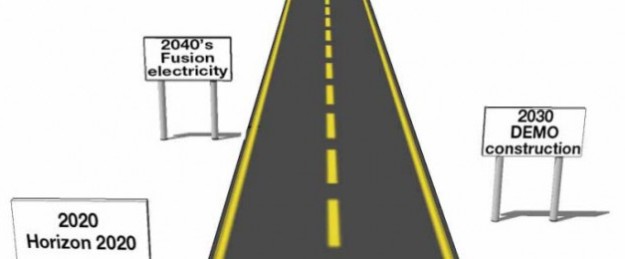Jan 17 2013
The European Fusion Development Agreement (EFDA) has published a roadmap which outlines how to supply fusion electricity to the grid by 2050. The roadmap to the realisation of fusion energy breaks the quest for fusion energy down into eight missions. For each mission, it reviews the current status of research, identifies open issues, proposes a research and development programme and estimates the required resources. It points out the needs to intensify industrial involvement and to seek all opportunities for collaboration outside Europe.
 Roadmap-illustration
Roadmap-illustration
The goal of fusion research is to make the energy of the stars available on Earth by fusing hydrogen nuclei. Fusion energy is nearly unlimited as it draws on the abundant raw materials deuterium and lithium. It does not produce greenhouse gases or long-lived radioactive waste. It is intrinsically safe, as chain reactions are impossible.
So far, fusion scientists have succeeded in generating fusion power, but the required energy input was greater than the output. The international experiment ITER, which starts operating in 2020, will be the first device to produce a net surplus of fusion power, namely 500 megawatts from a 50 megawatt input.
Europe holds a leading position in fusion research and hosts ITER. The fact that the ITER project is funded and run by six other nations besides Europe reflects the growing expectations on fusion energy. China, for instance, is launching an aggressive programme aimed at fusion electricity well before 2050. “Europe can keep pace only if it focusses its effort and pursues a pragmatic approach to fusion energy” states Dr Francesco Romanelli, EFDA Leader.
Focussing on the research and engineering activities needed to achieve fusion electricity, the roadmap shows that these can be carried out within a reasonable budget. The amount of resources proposed are of the same level as those originally recommended for the seventh European Research Framework Programme – outside the European investment in the ITER construction.
The roadmap covers three periods: The upcoming European Research Framework Programme, Horizon 2020, the years 2021-2030 and the time between 2031 and 2050.
ITER is the key facility of the roadmap as it is expected to achieve most of the important milestones on the path to fusion power. Thus, the vast majority of resources proposed for Horizon 2020 are dedicated to ITER and its accompanying experiments. The second period is focussed on maximising ITER exploitation and on preparing the construction of a demonstration power plant DEMO, which will for the first time supply fusion electricity to the grid. Building and operating DEMO is the subject of the last roadmap phase.
In the course of the roadmap implementation, the fusion programme will move from being laboratory-based and science-driven towards an industry- and technology-driven venture. ITER construction already generates a turnover of about 6 billion euro. The design, construction and operation of DEMO requires full involvement of industry to ensure that, after a successful DEMO operation, industry can take responsibility for commercial fusion power.